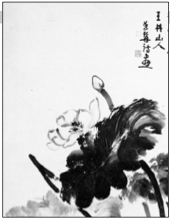
Cheng Man-ch’ing “Lotus” painting c. 1970
The Lotus
Lifting itself above the earth,
not stained by the dirty mud;
Placed in a simple surrounding
unexpectedly nature’s truth is revealed.
I paint the lotus flower,
but it laughs at me;
Its everlasting fragrance faces
a hundred-year-old mortal only for a moment.—Cheng Man-ch’ing, 1963
Translated by Dr. S. D. Ren
Born in 1902, Cheng Man-ch’ing was from Yongjia, Zhejiang Province in southeastern China. He was a bright, but sickly child. The family had become impoverished; their father died within a few years of Cheng’s birth. Raised in his mother’s family, Cheng showed artistic leanings at a young age. His mother taught him calligraphy, sang poetry to him, and took him along on herb-gathering walks. His mother’s sister Zhang Hongwei was a skilled artist; she also encouraged the young boy.
One day when around nine years old, Cheng was out playing with friends. Suddenly, something fell from above and struck him on the head. Cheng was knocked unconscious, but fortunately was revived with herbal remedies. However, his memory was affected. His aunt’s painting teacher, Wang Xiangchan, took Cheng on as an assistant in his studio, having the boy grind ink and do simple tasks as he recovered his strength and memory. Cheng learned from watching, and as he got better, he painted more and more.
Cheng went to Hangzhou to study further and began to sell his paintings to help support the family. By around 1919, he moved to Beijing, where he taught poetry at Yuwen College. He became part of the artistic circles, and had a one-man show at the Shuixie Pavilion. Cheng then went to Shanghai, China’s artistic center, where he became involved with several prestigious art societies. He exhibited his works alongside such people as Wang Yiting, Huang Binhong, Xu Beihong, Zhang Daqian, Ma Gongyu, and his own aunt Zhang Hongwei. He taught at a number of schools, including the famed Shanghai College of Art.
While in Shanghai, Cheng Man-ch’ing suffered from overwork, and was stricken with tuberculosis. He treated himself with herbs and by practicing taijiquan. During this time, he took up serious study of Chinese medicine with Dr. Song You’an. After completing his studies with Song, he hung out his shingle, and soon earned the nickname “One-dose Cheng” for the efficacy of his prescriptions. Cheng put his medical skills to use during the Sino-Japanese war. He even became a medical advisor to Chiang Kai-shek. He refused payment from those who had little money. Cheng later wrote several tracts on traditional herbal medicine.
In the 1930s Cheng Man-ch’ing studied taijiquan with the famed Yang Chengfu, and he helped Yang write his second book, The Substance and Application of Taijiquan. Cheng’s abilities in taijiquan grew, which led him to teach at the Huangpo Military Academy (China’s West Point), and the Honan Province Martial Arts Bureau. In the process, he created a “short form” of taijiquan in hopes of spreading it further by making it easier to learn. In the 1940s, Cheng wrote his influential Cheng-tzu’s Thirteen Treatises on T’ai Chi Ch’uan. This book was published after he relocated with his family to Taiwan in 1949. Cheng Man-ch’ing taught public classes in Taibei, and formed the Shih Chung T’ai Chi Ch’uan Study Association, which continues to this day. In Cheng’s hands, taijiquan was far from limited to fighting. He saw it as being one more vehicle for the study of the Dao, and as an excellent health exercise for all people.
In Taiwan, Cheng Man-ch’ing continued to see patients. He participated in the legislature, and supported the Cultural Renaissance Movement. With a half-dozen art colleagues he created the “Seven Friends of Painting.” Cheng also served as one of Song Meiling’s painting tutors, the other being landscape artist Huang Junbi.
In late 1963, Cheng Man-ch’ing and his wife visited Europe, where he had a one-man show at the Museé Cernuschi in Paris. After New Years, they visited New York City, and decided to resettle there, ultimately bringing their five children there from Taiwan. Cheng began teaching taijiquan in New York’s Chinatown, at first at the New York T’ai Chi Ch’uan Association at 211 Canal Street, and later, in 1971, forming the Shr Jung Association, which met at 87 Bowery. He was one of the first Chinese masters to teach openly in the US and to take on non-Chinese students.
Cheng wrote several more books about taijiquan and with the assistance of his students, created several films. He held many solo exhibits, including the Hudson Valley Museum, and the FAR Gallery in New York City, contributing pieces to an exhibit at the 1964–65 World’s Fair Republic of China pavilion, as well as continuing to regularly exhibit in Taiwan. His artwork is reproduced in several collections.
Cheng Man-ch’ing spent his last eleven years between New York City and Taibei, teaching taijiquan, doing herbal consultations, writing, painting, and exhibiting his art. He wrote at least a dozen books during this period—on poetry, philosophy, taijiquan, medicine, and the arts. Cheng passed away in 1975 while on an extended stay in Taiwan.
—Barbara Davis, M.A.
Project Director
For a list of works by and about Cheng Man-ch’ing’s works, visit our Writings page.

You must be logged in to post a comment.